The Google Pixel C Review
by Brandon Chester & Joshua Ho on January 25, 2016 8:00 AM ESTSystem Performance
One of the highlights of the Pixel C is the fact that it is powered by NVIDIA's Tegra X1 SoC. This technically isn't the first time that X1 has shown up in an Android device since it powers the SHIELD Android TV, but it's the first time it has been used in a mobile device. This implementation of Tegra X1 has four Cortex A57 cores with a peak frequency of 1.91GHz, along with four Cortex A53 cores. There are a few things that need to be mentioned about how Tegra X1 differs from other SoCs with eight cores. The first is the fact that in theory, Tegra X1 uses cluster migration rather than Heterogeneous Multi-processing. The reason I said in theory is because the implementation in the Pixel C is really only using the A57 cluster and scaling the frequency as low as 51MHz and as high as 1.91GHz.
In any case, all of our benchmarks should trigger the A57 cores in a mobile device that pairs A53 and A57 cores, so the discussion of the A53 cores being disabled is more relevant from a power consumption standpoint than a performance one. To analyze the general performance of the Pixel C I've run it through our standard JavaScript tests, along with PCMark and BaseMark OS II.
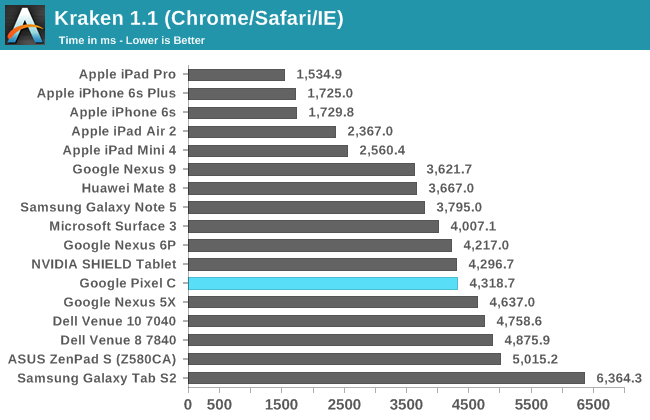
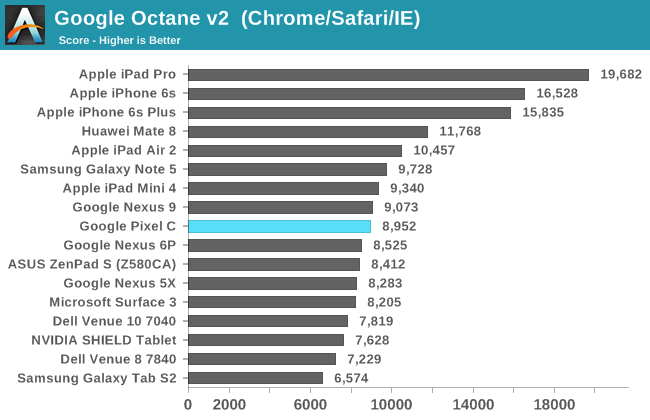

Unfortunately, the Pixel C doesn't make a very strong showing in our JavaScript benchmarks. I can't help but feel that this is the result of a rushed Android build, as there are regressions compared to the Nexus 9 in Octane and Kraken, and in all cases the score just isn't that impressive. JavaScript performance is definitely something Google will have to work on in the future, as the gap between the performance of iOS and Android devices is growing fairly large.

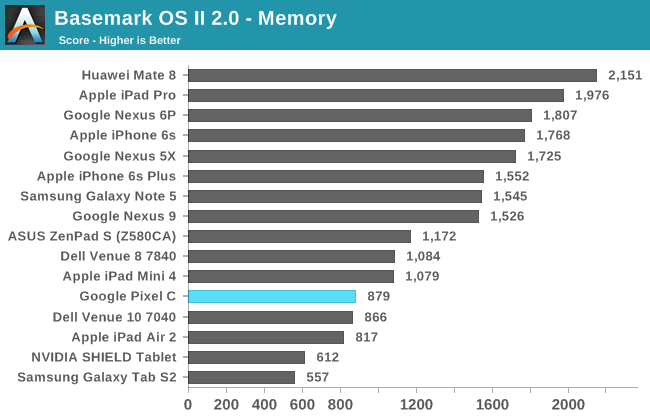
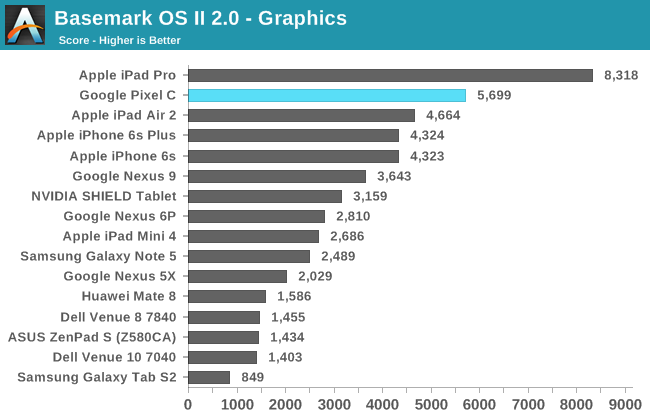


The Pixel C only achieves decent results in BaseMark OS II. The NAND memory score definitely drags down the overall rating, with the web score being lower than expected, and the system score being shocking low. The stand out score is in the graphics test, with the Pixel C only coming second to Apple's iPad Pro, and beating out the next best Android device, which is also NVIDIA-powered, by a huge margin. Unfortunately, high as it may be, Tegra X1's graphics performance just isn't enough to carry the Pixel C here.
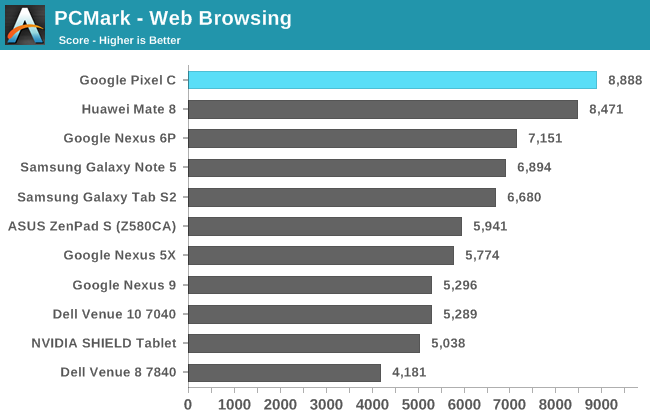
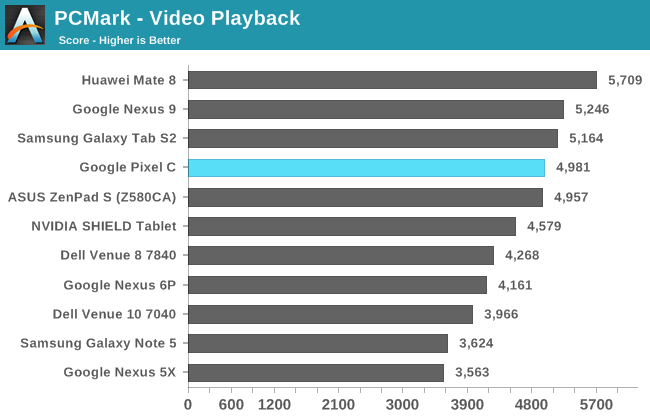

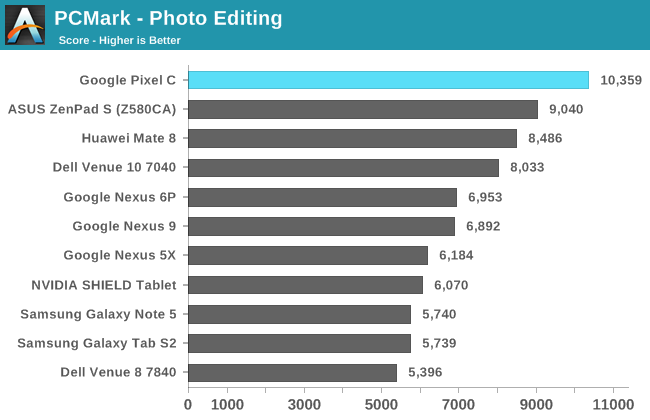
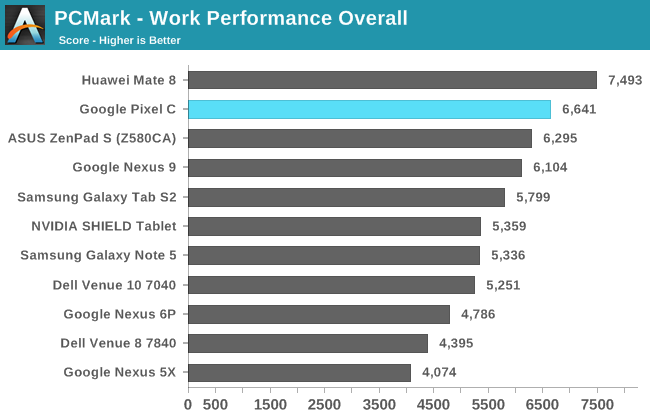
PCMark paints a different picture than BaseMark OS II, and highlights how performance can be highly variable based on workload, software, and whether an app is run as a native binary or through ART. In PCMark the Pixel C performs exceptionally well, with the exception of the writing test which seems to have been impacted by some change made to ART on Google's devices when moving to Marshmallow. Putting that aside, we see quite high and often chart topping scores in the remaining tests, resulting in a final score that only sits below the Huawei Mate 8.
Characterizing the Pixel C's performance is difficult. PCMark paints a very good picture, and I'm tempted to lean toward it as it is representative of the tasks that users will perform on a daily basis. There's a bit more discussion to be had about the Pixel C's general performance, and that'll come a bit later in the software section of the review. What I can say is that Tegra X1 certainly is fast as far as raw speed goes, but there's more to be said about the Pixel C's performance when you consider the role of both hardware and software.










122 Comments
View All Comments
testbug00 - Tuesday, January 26, 2016 - link
Turns them off right at boot.Kepe - Monday, January 25, 2016 - link
Oh man, I've been looking for a new (Android) tablet for a while now to replace my HP Touchpad from 2012 (running Marshmallow, btw). I haven't found a single device that has a decent, modern SOC, resolution of 1920x1080 or higher and a decent price tag.Google really needs to step its game up if it wants to stay relevant in the tablet market. Android needs better tablet features and apps that take advantage of the screen real estate. Device manufacturers clearly aren't very interested in making decent Android tablets at the moment, and app developers aren't very interested in making their apps tablet-friendly.
thestryker - Monday, January 25, 2016 - link
I was in much the same boat as I really don't see the point in smaller tablets... I have a phone with a 5" screen, if I'm reaching for a different device it had better offer some screen real estate. I ended up stumbling across the LG G PAD II 10.1 (V940N) and was shocked that nobody seemed to be talking about it at all, including LG who makes it.It's definitely not the fastest available, but it cost $300 (I got one as soon as I found a retailer with it) for a 1920x1200 display, Snapdragon 800 (MSM8974), 2GB RAM and 16GB storage. The build quality is rather sturdy for something that inexpensive, battery life is solid and I really haven't had any issues with it. LG's software isn't very intrusive, and they have a very good multitasking setup (though quite limited in what it works with) that has worked very well the few times I've used it.
This type of device is exactly what I wish was talked about more, because I feel like that's the sweet spot which can be available with google via android. Things like this definitely aren't on the radar for tech news, and obviously not even the companies who make them unfortunately.
5th element - Monday, January 25, 2016 - link
I'm in the same boat, I'm still on a nexus 7 2013 and want a worthy replacement. It seems like a good SoC with a great screen in wide-screen is hard to come by 😑deppman - Friday, January 29, 2016 - link
The Shield tablet is already far superior to the Nexus 7 2013 in almost every respect, with 2-4x with performance in some cases, runs Android 6 and has neat Nvidia extras like gforce now, mini hdmi out, and a very usable sdcard. Check out how it performs in these charts. And its $199.The rumored upcoming x1 version (March?) should be even more capable, but that is still just a rumor.
Teknobug - Monday, January 25, 2016 - link
ugh no thankszeeBomb - Monday, January 25, 2016 - link
Don't to need to even read... This is disappointing!Pjotr - Monday, January 25, 2016 - link
And how hard is it to start selling the Pixel C in Sweden and the other Nordic countries!? I don't want the keyboard, just a Google tablet. I can't order Nexus 9 anymore, it's been discontinued... so Google has no tablet on offer!deppman - Friday, January 29, 2016 - link
When you go to the play store, click on "view all tablets" and you should find the nexus 9 there.I own one, and it is sublime: an excellent display, fast, sturdy, and very comfortable to hold. I much prefer the soft-touch back to my all-metal tablet (a tf701t). You can get one there or from many retailers for less than an iPad mini.
If you wish to play games though, the best tablet IMO is still the shield tablet.
thelongdivider - Monday, January 25, 2016 - link
I don't understand why android manufacturers don't focus more on storage. One of the biggest revolutions for me in the computer space was going from a HDD to an SSD, and yet android continues to use some of the lowest quality flash they can find. Responsiveness won't improve by going from 4 to 8 cores and using the same terrible flash...